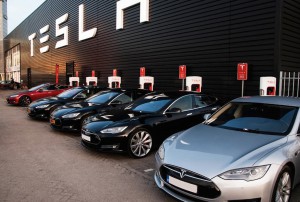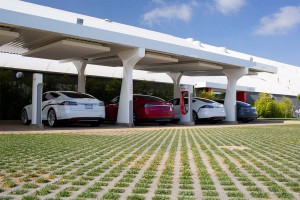
Tesla owners can now be charged an "idling fee" if they leave their vehicle in a charging stall after its fully charged.
As Tesla charges ahead with construction of its Gigafactory in the Nevada desert, it got a bit of welcome news: Panasonic Corp. is investing $256 million into its production facility.
However, it’s the plant in Buffalo, New York, where Tesla makes photovoltaic cells and modules, not the Gigafactory. The investment isn’t much of a surprise really as the two companies have been partners for years, including in the factory just outside of Reno.
In this case, the California-based company is making a long-term purchase commitment from Panasonic as part of the deal, in addition to providing factory space and infrastructure.
The two companies said in a statement that production of modules is expected to begin in the summer of 2017 and increase to one gigawatt of production by 2019. It is part of an agreement between the two that was first announced in October.
(Major automakers team up on ultrafast chargers for Europe. For more, Click Here.)
Tesla is working exclusively with Panasonic to supply batteries for its upcoming Model 3, the company’s first mass-market car. Panasonic already exclusively produces batteries for the Model S and Model X.
The new deal comes as Tesla’s founder recently hinted in a tweet that higher capacity superchargers are part of the company’s near-term plans. During an exchange on Twitter, Musk was asked about when more solar arrays will be installed at the company’s charging stations.
Musk said the installations were ongoing, but that a full-on rollout would require Tesla’s new “Supercharger V3.”
(Click Here for details about Tesla shareholders approving the SolarCity buyout.)
“There are some installed already, but full rollout really needs Supercharger V3 and Powerpack V2, plus SolarCity. Pieces now in place,” he tweeted.
Tesla upgraded its superchargers to achieve a power output of 145 kilowatts earlier this year, but Musk believes that the output could be increased to more than 350 kW. That kind of output results in faster charging: less than 15 minutes.
The company’s new iteration would likely set a new industry benchmark, although BMW, Daimler, Ford, and VW teamed up to develop 400 ultra-fast charging stations throughout Europe. That increase in speed may come in handy after some Tesla owners had to wait for hours on end during the holiday weekend at charging stations.
(Click Here for details about Tesla’s plan to raise more cash.)
The average Tesla currently takes about 90 minutes to fully charge using the superchargers; however, some owners were simply plugging their vehicles in and walking away to get a bite to eat, causing delays by sitting in the stall for more than two hours. To combat that, Tesla is now charging a 40-cent per minute “idling fee” for vehicles left on chargers after they’re fully charged.

